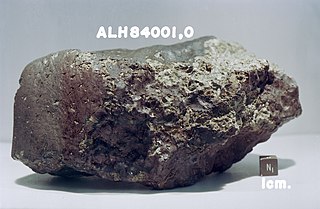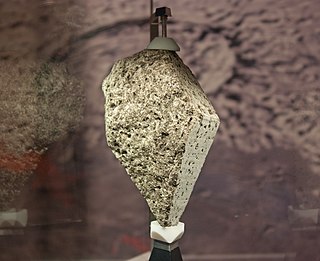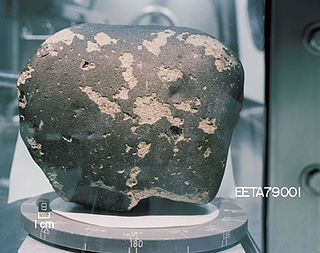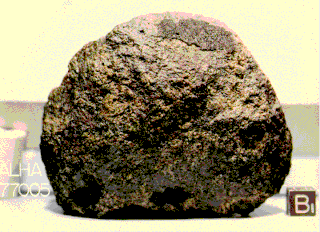Related Research Articles

A meteorite is a solid piece of debris from an object, such as a comet, asteroid, or meteoroid, that originates in outer space and survives its passage through the atmosphere to reach the surface of a planet or moon. When the original object enters the atmosphere, various factors such as friction, pressure, and chemical interactions with the atmospheric gases cause it to heat up and radiate energy. It then becomes a meteor and forms a fireball, also known as a shooting star; astronomers call the brightest examples "bolides". Once it settles on the larger body's surface, the meteor becomes a meteorite. Meteorites vary greatly in size. For geologists, a bolide is a meteorite large enough to create an impact crater.

A Martian meteorite is a rock that formed on Mars, was ejected from the planet by an impact event, and traversed interplanetary space before landing on Earth as a meteorite. As of September 2020, 277 meteorites had been classified as Martian, less than half a percent of the 72,000 meteorites that have been classified. The largest complete, uncut Martian meteorite, Taoudenni 002, was recovered in Mali in early 2021. It weighs 14.5 kilograms and is on display at the Maine Mineral & Gem Museum.

Allan Hills 84001 (ALH84001) is a fragment of a Martian meteorite that was found in the Allan Hills in Antarctica on December 27, 1984, by a team of American meteorite hunters from the ANSMET project. Like other members of the shergottite–nakhlite–chassignite (SNC) group of meteorites, ALH84001 is thought to have originated on Mars. However, it does not fit into any of the previously discovered SNC groups. Its mass upon discovery was 1.93 kilograms (4.3 lb).

Nanobacterium is the unit or member name of a former proposed class of living organisms, specifically cell-walled microorganisms, now discredited, with a size much smaller than the generally accepted lower limit for life. Originally based on observed nano-scale structures in geological formations, the status of nanobacteria was controversial, with some researchers suggesting they are a new class of living organism capable of incorporating radiolabeled uridine, and others attributing to them a simpler, abiotic nature. One skeptic dubbed them "the cold fusion of microbiology", in reference to a notorious episode of supposed erroneous science. The term "calcifying nanoparticles" (CNPs) has also been used as a conservative name regarding their possible status as a life form.

Magnesite is a mineral with the chemical formula MgCO
3. Iron, manganese, cobalt, and nickel may occur as admixtures, but only in small amounts.
Ben J. Bussey is an American planetary scientist.

ANSMET is a program funded by the Office of Polar Programs of the National Science Foundation that looks for meteorites in the Transantarctic Mountains. This geographical area serves as a collection point for meteorites that have originally fallen on the extensive high-altitude ice fields throughout Antarctica. Such meteorites are quickly covered by subsequent snowfall and begin a centuries-long journey traveling "downhill" across the Antarctic continent while embedded in a vast sheet of flowing ice. Portions of such flowing ice can be halted by natural barriers such as the Transantarctic Mountains. Subsequent wind erosion of the motionless ice brings trapped meteorites back to the surface once more where they may be collected. This process concentrates meteorites in a few specific areas to much higher concentrations than they are normally found everywhere else. The contrast of the dark meteorites against the white snow, and lack of terrestrial rocks on the ice, makes such meteorites relatively easy to find. However, the vast majority of such ice-embedded meteorites eventually slide undiscovered into the ocean.

Moon rock or lunar rock is rock originating from Earth's Moon. This includes lunar material collected during the course of human exploration of the Moon, and rock that has been ejected naturally from the Moon's surface and landed on Earth as meteorites.
Kaidun is a meteorite that fell on 3 December 1980 on a Soviet military base near what is now Al-Khuraybah in Yemen. A fireball was observed travelling from the northwest to the southeast, and a single stone weighing about 2 kilograms (4.4 lb) was recovered from a small impact pit. It has been suggested that Kaidun originated from the Martian moon of Phobos, but this is disputed.

Nakhla is a Martian meteorite which fell in Egypt in 1911. It was the first meteorite reported from Egypt, the first one to suggest signs of aqueous processes on Mars, and the prototype for Nakhlite type of meteorites.

Meteorite hunting is the search for meteorites. A person engaged in the search for meteorites is known as a meteorite hunter. Meteorite hunters may be amateurs who search on the weekends and after work, or professionals who recover meteorites for a living. Both frequently use tools such as metal detectors or magnets to discover the meteorites.
Mars may contain ores that would be very useful to potential colonists. The abundance of volcanic features together with widespread cratering are strong evidence for a variety of ores. While nothing may be found on Mars that would justify the high cost of transport to Earth, the more ores that future colonists can obtain from Mars, the easier it would be to build colonies there.

The composition of Mars covers the branch of the geology of Mars that describes the make-up of the planet Mars.

The Tissint meteorite is a Martian meteorite that fell in Tata Province in the Guelmim-Es Semara region of Morocco on July 18, 2011. Tissint is the fifth Martian meteorite that people have witnessed falling to Earth, and the first since 1962. Pieces of the meteorite are on display at several museums, including the Museum of Natural History of Vienna and the Natural History Museum in London.

Planetary science is the scientific study of planets, celestial bodies and planetary systems and the processes of their formation. It studies objects ranging in size from micrometeoroids to gas giants, aiming to determine their composition, dynamics, formation, interrelations and history. It is a strongly interdisciplinary field, which originally grew from astronomy and Earth science, and now incorporates many disciplines, including planetary geology, cosmochemistry, atmospheric science, physics, oceanography, hydrology, theoretical planetary science, glaciology, and exoplanetology. Allied disciplines include space physics, when concerned with the effects of the Sun on the bodies of the Solar System, and astrobiology.
This is a glossary of terms used in meteoritics, the science of meteorites.

Northwest Africa 7034 is a Martian meteorite believed to be the second oldest yet discovered. It is estimated to be two billion years old and contains the most water of any Martian meteorite found on Earth. Although it is from Mars it does not fit into any of the three SNC meteorite categories, and forms a new Martian meteorite group named "Martian ". Nicknamed "Black Beauty", it was purchased in Morocco and a slice of it was donated to the University of New Mexico by its American owner. The image of the original NWA 7034 was photographed in 2012 by Carl Agee, University of New Mexico.

Elephant Moraine 79001, also known as EETA 79001, is a Martian meteorite. It was found in Elephant Moraine, in the Antarctic during the 1979–1980 collecting season.

Yamato 000593 is the second largest meteorite from Mars found on Earth. Studies suggest the Martian meteorite was formed about 1.3 billion years ago from a lava flow on Mars. An impact occurred on Mars about 11 million years ago and ejected the meteorite from the Martian surface into space. The meteorite landed on Earth in Antarctica about 50,000 years ago. The mass of the meteorite is 13.7 kg (30 lb) and has been found to contain evidence of past water alteration.

Allan Hills 77005 is a Martian meteorite that was found in the Allan Hills of Antarctica in 1977 by a Japanese National Institute of Polar Research mission team and ANSMET. Like other members of the group of SNCs, ALH-77005 is thought to be from Mars.
References
- ↑ "Department of Mineral Science Staff". Department of Mineral Science Staff. Smithsonian Institution. Retrieved 27 March 2015.
- 1 2 "9924 Corrigan (1981 EM24)". Minor Planet Center. Retrieved 22 April 2017.
- ↑ CORRIGAN, Catherine M.; HARVEY, Ralph P. (January 2004). "Multi-generational carbonate assemblages in martian meteorite Allan Hills 84001: Implications for nucleation, growth, and alteration". Meteoritics & Planetary Science. 39 (1): 17–30. Bibcode:2004M&PS...39...17C. doi: 10.1111/j.1945-5100.2004.tb00047.x .
- 1 2 McCoy, Tim (1 February 2008). "Staff changes at the Smithsonian". Antarctic Meteorite Newsletter. 31 (1): 3. Retrieved 28 March 2015.
- ↑ Corrigan, Catherine. "Catherine Corrigan". Department of Mineral Sciences Staff: Catherine Corrigan. Smithsonian Institution. Retrieved 29 March 2015.
- ↑ Shatterwhite, Cecilia; Rightner, Kevin (July 2004). "Special edition ... Announcing the Availability of a New Martian Meteorite" (PDF). Antarctic Meteorite Newsletter. 27 (2): 2. Retrieved 30 March 2015.
- ↑ "Antarctic meteorite Newsletter". Antarctic Meteorite Newsletter. NASA Johnson Space Center. Retrieved 28 March 2015.
- ↑ "Catherine Corrigan: Geologist and Curator of Antarctic Meteorites". Q?rius. Smithsonian National Museum of Natural History. Retrieved 28 March 2015.
- ↑ "Moon Zoo Team". Moon Zoo Team. Zooniverse. Archived from the original on 3 April 2015. Retrieved 28 March 2015.
- ↑ "About the Society: Other Personnel". The Meteoritical Society. The Meteoritical Society. Retrieved 30 March 2015.
- ↑ "MPC/MPO/MPS Archive". Minor Planet Center. Retrieved 22 April 2017.